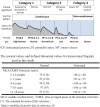The Utility of a Point-of-Care Transcranial Doppler Ultrasound Management Algorithm on Outcomes in Pediatric Asphyxial Out-of-Hospital Cardiac Arrest - An Exploratory Investigation
- PMID: 35155456
- PMCID: PMC8832099
- DOI: 10.3389/fmed.2021.690405
The Utility of a Point-of-Care Transcranial Doppler Ultrasound Management Algorithm on Outcomes in Pediatric Asphyxial Out-of-Hospital Cardiac Arrest - An Exploratory Investigation
Abstract
Background: Transcranial Doppler ultrasound is a sensitive, real time tool used for monitoring cerebral blood flow; it could provide additional information for cerebral perfusion in cerebral resuscitation during post cardiac arrest care. The aim of the current study was to evaluate the utility of a point-of-care transcranial Doppler ultrasound management algorithm on outcomes in pediatric asphyxial out-of-hospital cardiac arrest.
Methods: This retrospective cohort study was conducted in two tertiary pediatric intensive care units between January 2013 and June 2018. All children between 1 month and 18 years of age with asphyxial out-of-hospital cardiac arrest and a history of at least 3 min of chest compressions, who were treated with therapeutic hypothermia and survived for 12 h or more after the return of circulation were eligible for inclusion.
Results: Twenty-one patients met the eligibility criteria for the study. Sixteen (76.2%) of the 21 children were male, and the mean age was 2.8 ± 4.1 years. Seven (33.3%) of the children had underlying disorders. The overall 1-month survival rate was 52.4%. Twelve (57.1%) of the children received point-of-care transcranial Doppler ultrasound. The 1-month survival rate was significantly higher (p = 0.03) in the point-of-care transcranial Doppler ultrasound group (9/12, 75%) than in the non-point-of-care transcranial Doppler ultrasound group (2/9, 22.2%).
Conclusions: Point-of-care transcranial Doppler ultrasound group was associated with a significantly better 1-month survival rate compared with no point-of-care transcranial Doppler ultrasound group in pediatric asphyxial out-of-hospital cardiac arrest.
Keywords: asphyxial; out-of-hospital cardiac arrest; pediatric; point-of-care; transcranial Doppler ultrasound.
Copyright © 2022 Lin, Kuo, Hsia, Lin, Wang, Hsu, Chiang, Chan, Lee and Lin.
Conflict of interest statement
The authors declare that the research was conducted in the absence of any commercial or financial relationships that could be construed as a potential conflict of interest.
Figures



Similar articles
-
72-h therapeutic hypothermia improves neurological outcomes in paediatric asphyxial out-of-hospital cardiac arrest-An exploratory investigation.Resuscitation. 2018 Dec;133:180-186. doi: 10.1016/j.resuscitation.2018.08.019. Epub 2018 Aug 22. Resuscitation. 2018. PMID: 30142398
-
Transcranial Doppler ultrasound in therapeutic hypothermia for children after resuscitation.Resuscitation. 2015 Apr;89:182-7. doi: 10.1016/j.resuscitation.2015.01.029. Epub 2015 Feb 4. Resuscitation. 2015. PMID: 25659371
-
Early Clinical Predictors of Neurological Outcome in Children With Asphyxial Out-of-Hospital Cardiac Arrest Treated With Therapeutic Hypothermia.Front Pediatr. 2020 Jan 17;7:534. doi: 10.3389/fped.2019.00534. eCollection 2019. Front Pediatr. 2020. PMID: 32010648 Free PMC article.
-
Prognostic value of point-of-care ultrasound during cardiac arrest: a systematic review.Cardiovasc Ultrasound. 2020 Jan 13;18(1):1. doi: 10.1186/s12947-020-0185-8. Cardiovasc Ultrasound. 2020. PMID: 31931808 Free PMC article.
-
Transcranial Doppler Sonography in Pediatric Neurocritical Care: A Review of Clinical Applications and Case Illustrations in the Pediatric Intensive Care Unit.J Ultrasound Med. 2015 Dec;34(12):2121-32. doi: 10.7863/ultra.15.02016. Epub 2015 Nov 16. J Ultrasound Med. 2015. PMID: 26573100 Review.
Cited by
-
Transcranial Doppler Ultrasound, a Review for the Pediatric Intensivist.Children (Basel). 2022 May 16;9(5):727. doi: 10.3390/children9050727. Children (Basel). 2022. PMID: 35626904 Free PMC article. Review.
-
Noninvasive Neuromonitoring Modalities in Children Part I: Pupillometry, Near-Infrared Spectroscopy, and Transcranial Doppler Ultrasonography.Neurocrit Care. 2024 Feb;40(1):130-146. doi: 10.1007/s12028-023-01730-4. Epub 2023 May 9. Neurocrit Care. 2024. PMID: 37160846 Review.
References
LinkOut - more resources
Full Text Sources
Miscellaneous

